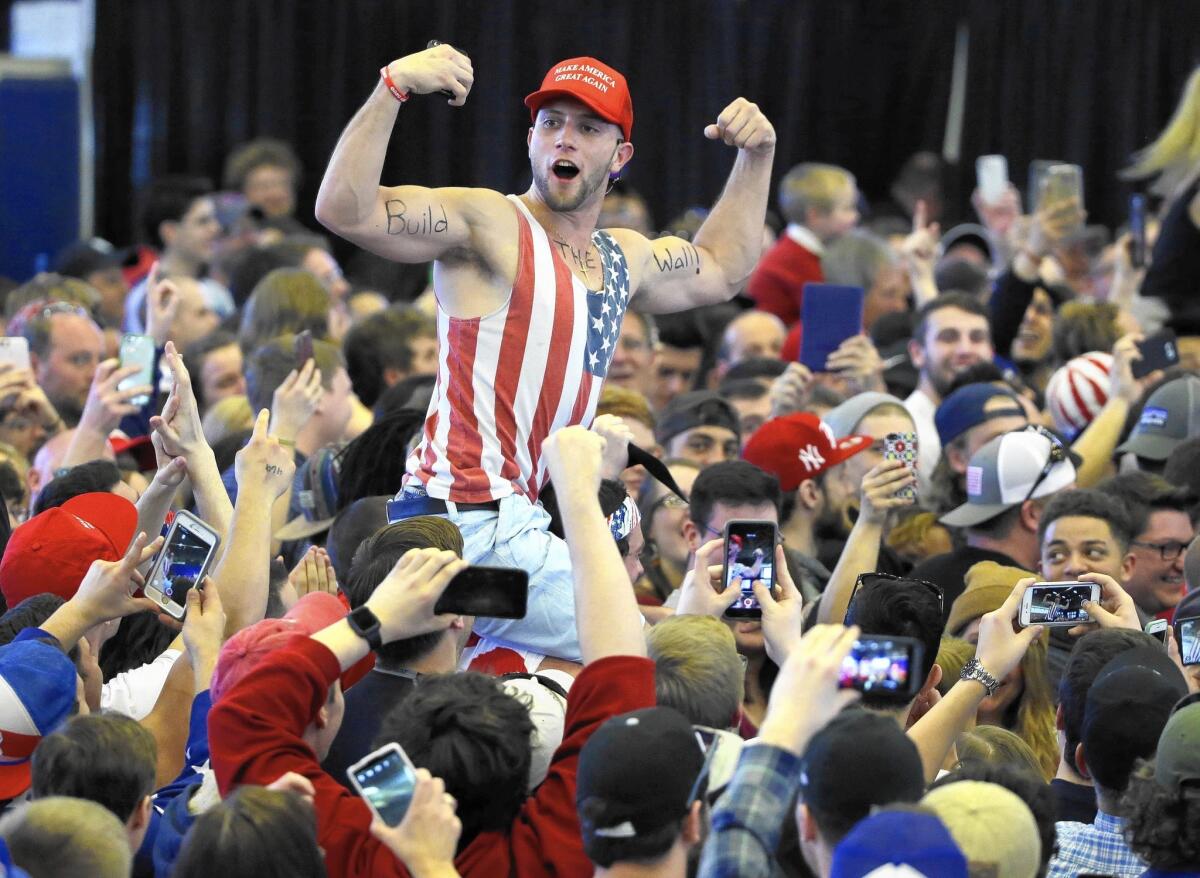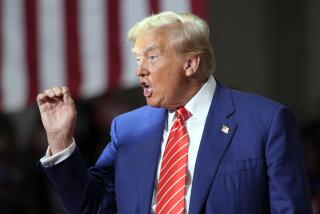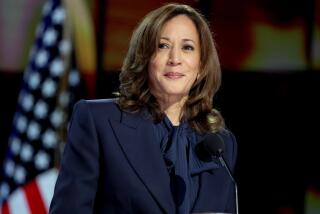Strong Sanders and Trump runs reflect and inspire upheaval in Democratic and Republican parties

Reporting from NEW YORK — Beyond the contentious backbiting of the presidential contest, the nation’s major political parties are undergoing a dramatic and potentially long-lasting cultural shift.
Both of the outsider challengers — Donald Trump and Bernie Sanders — are campaigning in part against the parties they hope to lead. Both have gained much of their success from confounding what has been mainstream party thought for decades.
As the nominating battles move into their final phase, Sanders has yanked his party leftward — or, at a minimum, greatly hastened a change that was already underway. Trump has pushed against the Republican Party on issues as small as delegate selection and as large as foreign policy and brought with him ground troops to enforce his views. The second-place Republican, Texas Sen. Ted Cruz, has made a career of defying Republican leaders, even if Trump is now attacking him as part of the establishment.
The redefinition is occurring on a political landscape shaking from the continued aftershocks of the 2008 economic collapse. That territory has proved inhospitable, to different degrees, to more traditional politicians like Hillary Clinton and Ohio Gov. John Kasich, extending her nomination battle and blunting his candidacy.
“All things being equal, if you’d showed up from Mars you would think Hillary Clinton would have this wrapped up,” said Lee Miringoff, a pollster at Marist College with long experience in presidential politics. “And you would have thought Kasich on paper would be stronger. But he’s 1 for 30, and that was Ohio.”
The lasting effect of the Great Recession is not the only force that has propelled the parties’ movement. So, too, has the changing face of America. Among Democrats, a more youthful electorate has contributed to the success of Sanders’ effort; among Republicans, blue-collar whites who in many cases feel threatened by the rise of other groups have powered Trump’s campaign.
Tellingly, the outsider candidacies are in some cases sounding similar themes. Both Trump and Sanders, coming at it from opposite ideological sides, have pressed to reverse trade deals they say have gutted American manufacturing jobs. Both have called for other countries to begin paying more for the NATO military alliance. Both have criticized their respective parties for the way delegates, who will determine the nominations, are selected.
“I’m not a fan of Bernie Sanders, but it’s a rigged system,” Trump said Friday in Plattsburgh, N.Y. “The Republican system is rigged. It’s a rigged system.”
Both parties have changed over the years, usually when successive losses opened their eyes to the need. Republican leaders set out after the 2012 election to ensure that the next presidential nominee was more attractive to women, Latinos and young voters, believing that to be the route to success. Democrats lurched from the left to the center in 1992 after losing five of six previous presidential contests. Both moves have been confounded this year by the surprisingly successful guerrilla candidacies of Trump and Sanders.
For Democrats, the repudiation is fed by the party’s growing liberalism. In exit polls during the 2008 Ohio primary, 41% of Democratic voters described themselves as liberal. By last month’s Ohio primary, that figure had jumped by nearly half, to 59%. National surveys show Americans elsewhere also are increasingly gravitating to the political poles.
Sanders is relentless in his criticism of the more centrist Democratic era and of Hillary Clinton’s role in it. Central to his constellation of issues is her receipt of campaign money from Wall Street firms, a particular target of animosity since the 2008 financial collapse.
“It’s a system held in place by corrupt politics, where Wall Street banks and billionaires buy elections,” says a Sanders ad airing in New York. “The truth is, you can’t change a corrupt system by taking its money.”
Other issues Sanders has emphasized in his call for “political revolution” are highly popular among younger, more diverse and more liberal Democrats: universal healthcare, a minimum-wage hike, environmental protections, free public college and university tuition, and an end to those international trade deals.
Neither Sanders, a longtime political independent, nor his supporters are necessarily steeped in Democratic loyalty. In Thursday night’s debate, he seemed to slight the Southern states as outposts of conservatism, even though their Democrats are mostly African American and among the party’s most dependable voters.
It is those traditional Democrats whom Clinton is appealing to with a venerable, if liberal, Democratic message. She speaks to
persistent concerns about jobs and the economy, particularly among the blue-collar voters who long formed the party’s base, but in more cautious and typical rhetoric than Sanders deploys.
“A real plan to create new jobs in the industries of the future,” Clinton promises in one ad airing in New York.
Clinton came into the race expecting to benefit from a rosy glow surrounding her husband’s tenure, when the economy was soaring. But many of the voters drawn to Sanders’ message don’t remember the Clinton years. And the former first lady has been on defense on topics taken up in that era — like welfare reform, tough criminal justice measures and trade — that she did not have to confront nearly as profoundly in her 2008 campaign for president.
Clinton has sharpened her own rhetoric on those issues, but there are limits to how far she can go without seeming hypocritical. That has led to an oddity in New York: Among all of the candidates, it is Republican Kasich who more than anyone is touting Bill Clinton’s presidential years as a template for office.
In a speech last week to Republican women in Manhattan, Kasich praised the 1990s, when he served in Congress, and criticized the outsider Republicans as purveyors of “darkness.”
But Kasich’s approach isn’t selling to most Republicans this year. That is because voters have largely rejected two elements that have defined Republicans for two generations: traditional views on issues like trade and U.S. military engagement abroad, and the sunny approach used by past party idols like Ronald Reagan.
Trump’s attack on the Republican Party has been overt. Last week, he used the GOP-friendly op-ed pages of the Wall Street Journal to scorn the party.
“I, for one, am not interested in defending a system that for decades has served the interest of political parties at the expense of the people,” Trump’s op-ed said. “Members of the club — the consultants, the pollsters, the politicians, the pundits and the special interests — grow rich and powerful while the American people grow poorer and more isolated.”
Trump’s rhetoric plays on his supporters’ grievances about a raft of issues — the economy, President Obama’s healthcare law, the Supreme Court’s acceptance of gay marriage.
“They think their own party has not been standing up for them,” said James Campbell, a political scientist at the University at Buffalo. “It’s issue after issue.... There’s a buildup of anger, and frustration that’s boiled over into anger. It’s not just directed at Democrats but at Republicans as well.”
The changes afoot in the Republican and Democratic parties seem destined to extend past this election, regardless of who wins the nominations and the White House.
If nothing else, Trump’s success at castigating those in the country illegally has doomed establishment Republicans’ effort to soften their approach on immigration in order to attract Latino voters. Keeping the support of the blue-collar whites he has attracted — a necessity given that young and diverse Americans are going with the Democrats — also will lead to second-guessing of the GOP’s long-standing trade policies.
The campaign is also certain to extend what has been an internal Republican battle since the interventions in Iraq and Afghanistan under former President George W. Bush over how involved the U.S. should be overseas, and how much it should focus on domestic needs.
For Democrats, Sanders’ success presages a move toward a bigger role for government — in establishing healthcare for all, free public college tuition and an expansive jobs program — that runs counter to the more centrist views that have propelled Democratic presidential success for decades.
Older Democrats who remember the failures of the past are more skeptical of the political impact of expanding government, particularly in an era of caustically partisan divisions. But there is no doubt where the younger, more diverse and rising Democrats stand, as they have gravitated to Sanders in lopsided numbers.
Conflicts over each party’s core beliefs have been rumbling under the surface for a while. Now, with the assistance of a New York billionaire and a Vermont socialist, both of whom see their candidacies as outside the bounds of party politics, they are fully out in the open, with a visibility that promises changes ahead.
Twitter: @cathleendecker
More to Read
Get the L.A. Times Politics newsletter
Deeply reported insights into legislation, politics and policy from Sacramento, Washington and beyond. In your inbox three times per week.
You may occasionally receive promotional content from the Los Angeles Times.











